天津 英文介绍课前演讲PPT 超美
- 格式:pptx
- 大小:6.97 MB
- 文档页数:12
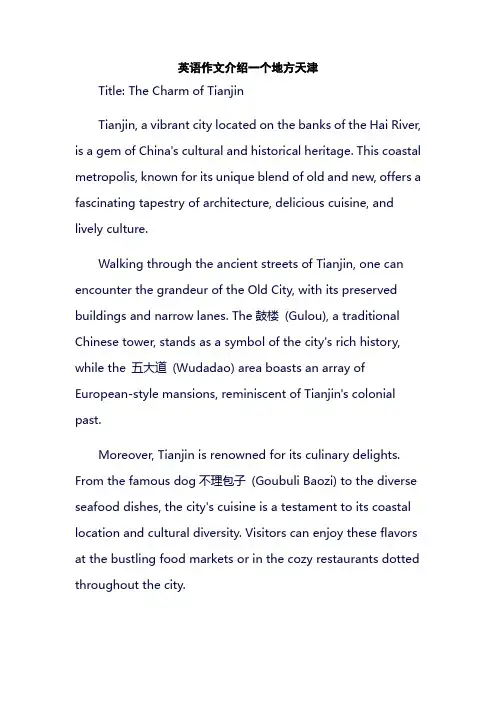
英语作文介绍一个地方天津Title: The Charm of TianjinTianjin, a vibrant city located on the banks of the Hai River, is a gem of China's cultural and historical heritage. This coastal metropolis, known for its unique blend of old and new, offers a fascinating tapestry of architecture, delicious cuisine, and lively culture.Walking through the ancient streets of Tianjin, one can encounter the grandeur of the Old City, with its preserved buildings and narrow lanes. The鼓楼(Gulou), a traditional Chinese tower, stands as a symbol of the city's rich history, while the 五大道(Wudadao) area boasts an array of European-style mansions, reminiscent of Tianjin's colonial past.Moreover, Tianjin is renowned for its culinary delights. From the famous dog不理包子(Goubuli Baozi) to the diverse seafood dishes, the city's cuisine is a testament to its coastal location and cultural diversity. Visitors can enjoy these flavors at the bustling food markets or in the cozy restaurants dotted throughout the city.In addition to its historical and culinary attractions, Tianjin is also a modern metropolis. The skyline is punctuated by towering skyscrapers, and the bustling streets are filled with shoppers and tourists. The Hai River Park offers a serene escape from the hustle and bustle, with its lush greenery and scenic river views.Finally, Tianjin's people are known for their warmth and friendliness. They are proud of their city's rich history and culture and are eager to share it with visitors. Whether it's a lively conversation in a local teahouse or a friendly greeting on the street, the people of Tianjin make the city even more charming.In conclusion, Tianjin is a city that embodies the best of both worlds: a rich historical heritage and a vibrant modern spirit. It is a must-visit destination for anyone interested in exploring China's diverse culture and culinary traditions.。
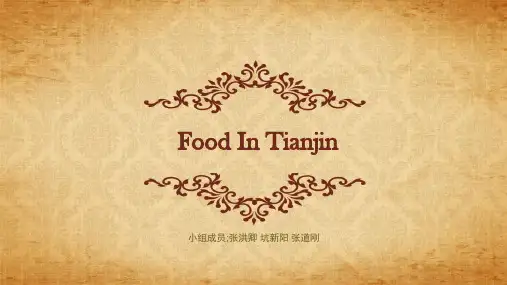
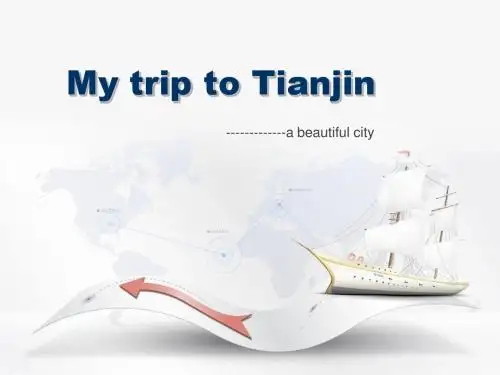
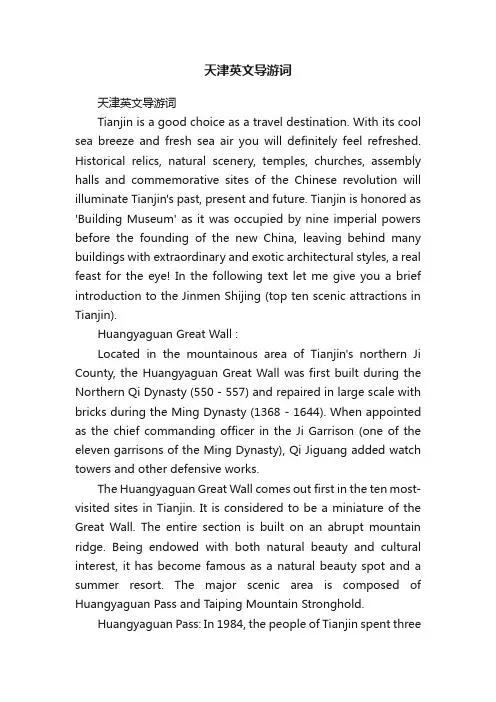
天津英文导游词天津英文导游词Tianjin is a good choice as a travel destination. With its cool sea breeze and fresh sea air you will definitely feel refreshed. Historical relics, natural scenery, temples, churches, assembly halls and commemorative sites of the Chinese revolution will illuminate Tianjin's past, present and future. Tianjin is honored as 'Building Museum' as it was occupied by nine imperial powers before the founding of the new China, leaving behind many buildings with extraordinary and exotic architectural styles, a real feast for the eye! In the following text let me give you a brief introduction to the Jinmen Shijing (top ten scenic attractions in Tianjin).Huangyaguan Great Wall :Located in the mountainous area of Tianjin's northern Ji County, the Huangyaguan Great Wall was first built during the Northern Qi Dynasty (550 - 557) and repaired in large scale with bricks during the Ming Dynasty (1368 - 1644). When appointed as the chief commanding officer in the Ji Garrison (one of the eleven garrisons of the Ming Dynasty), Qi Jiguang added watch towers and other defensive works.The Huangyaguan Great Wall comes out first in the ten most-visited sites in Tianjin. It is considered to be a miniature of the Great Wall. The entire section is built on an abrupt mountain ridge. Being endowed with both natural beauty and cultural interest, it has become famous as a natural beauty spot and a summer resort. The major scenic area is composed of Huangyaguan Pass and Taiping Mountain Stronghold.Huangyaguan Pass: In 1984, the people of Tianjin spent threeyears repairing 3,308 yards of the main wall from Banlagang Mountain in the east to Wangmaoding Mountain in the west. They restored 20 terraces, the Huangyaguan Water Gate, and the Bagua Castle (the Eight Diagrams Castle). The defensive system of the wall is complete. Watch towers, frontier cities, drain holes, emplacements, barracks and other indispensable military facilities are arranged orderly along the wall. Besides, the stele forests of the Great Wall, Beiji Temple, the exhibition hall of famous couplets, the Great Wall Museum (the first museum along the Great Wall) and the Phoenix Fortress have been newly built within the area.Taipingzhai Great Wall :Six miles southeast of Huangyaguan Pass is the Taipingzhai Great Wall, another important mountain stronghold of the wall during the Ming Dynasty (1368 - 1644). It is also called Taipinganzhai, meaning "a village of peace and prosperity". Starting from Banlagang Mountain in the east and arriving at Guafu Tower (Widow Tower) in the west, it winds through the precipitous mountains for about 955 yards.The wall is an important component of Huangyaguan Great Wall. There are six watch towers, one battlement, and one shortcut leading to the wall. The architectural styles of the military towers vary considerably. There are square, round, solid and hollow towers, with some inside and others outside the wall. Beside the shortcut, there is a small citadel where an 8.5-meter statue of Qi Jiguang, the chief commanding officer of Ji Garrison (one of the eleven garrisons in the Ming Dynasty) is located. The local people built this statue in order to commemorate his great contribution to frontier peace and stability in that period. To the west of the citadel, a section of the wall extends 33 yards out towhere a sentry post was situated.At the western end of the wall is a square stone tower called Guafu Tower, "Widow Tower" in English, built by twelve wives whose husbands died during the construction of the wall in the Ming Dynasty. The widows erected this tower to commemorate their husbands' notable exploits. The tower has two levels and measures 13-meters (14-yards) high. Arched arrow windows are on the four sides of the tower.Besides these cultural points of interest, Taipingzhai Great Wall is also famous for its amazingly impressive scenery. Zigzagging along the mountain ridge for over 984 yards, the wall looks very much like a giant dragon flying through clouds.Mt. Panshan Scenic Area :Covering an area of 106 square kilometers (about 26193 acres), Mt. Panshan Scenic Area is located in Jixian County, 110 kilometers (68.4 miles) away from Tianjin, 88 kilometers (54.7 miles) away from Beijing. As the name suggests, the scenic area is mainly Mt Panshan–oriented. Endowed with natural beauty and a historical heritage, Mt Panshan is known as 'The First Mountain East of Beijing' and is listed as one of the top fifteen mountains in China.The mountain acquired its present name, early in the Eastern Han (25-220). Taizong , the second emperor of the Tang Dynasty (618-907), was prodigal of his praise of its scenery on his chance visit when he led the army in a campaign. Seventy-two temples, thirteen pagodas and numerous Xanadus and towers were built on the mountain in the Ming Dynasty (1368-1644) and the Qing Dynasty (1644-1911). Qianlong, a brilliant and wise Qing Dynasty emperor was so impressed that he made thirty or so visits and wrote 1366 poems to express his admiration of the area. In thefirst half of the twentieth century, the whole resort all fell to ruin due to hostilities and neglect. It has undergone a process of restoration since the 1990s and is now regaining its fame.It is famous for jade pine trees, strange and astonishing peaks, clear waters, grotesquely shaped rocks and clusters of ancient temples. On the mountaintop, numerous pines hide the sky from view and block out the sunshine. Rugged rocks in a variety of shapes, some of which resemble a toad, a general or a boa, will greet you in the middle of the mountain. At its foot, clear water splashes on the rocks. The mountain consists of five peaks, with the main one, Guayue (Moon Hanging) Peak. Although Guayue Peak is only 857 meters (2811.7 feet) above sea level, to the north it is possible to see a section of the Great Wall while to the west Mt Taihang can be seen.From the Wei State during the Three Kingdoms Period (220-280) onwards, emperors enthusiastically commissioned the building of temples, towers and Xanadus resulting in over 160 such sites. There are four main temples: Tiancheng Temple (God Proposing Temple), Yunzhao Temple (Cloud-Hiding Temple), Wanfo Temple (Ten Thousand-Buddha Temple) and Wansong Temple (Ten Thousand-Pine Temple). Tiancheng Temple built in the Tang Dynasty, was enlarged and repaired in the Ming and the Qing dynasties. T o the east of this temple stands the Ancient Dagoba. As the biggest tower in this mountain, it has thirteen floors. The roof of the Yunzhao Temple was a golden yellow, a color that normally was only allowed to be used on imperial buildings. By granting permission for this, Emperor Qianlong demonstrated his approval and admiration of the mountain. Wanfo Temple (Ten Thousand-Buddha Temple) has 10,960 small Buddhas statues.。
![[英文PPT演讲]天津小吃介绍](https://uimg.taocdn.com/7ee8d516bb68a98271fefa34.webp)
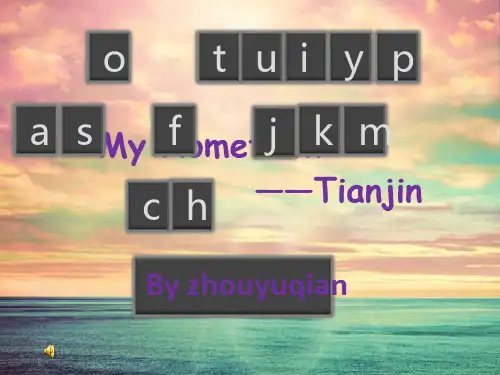
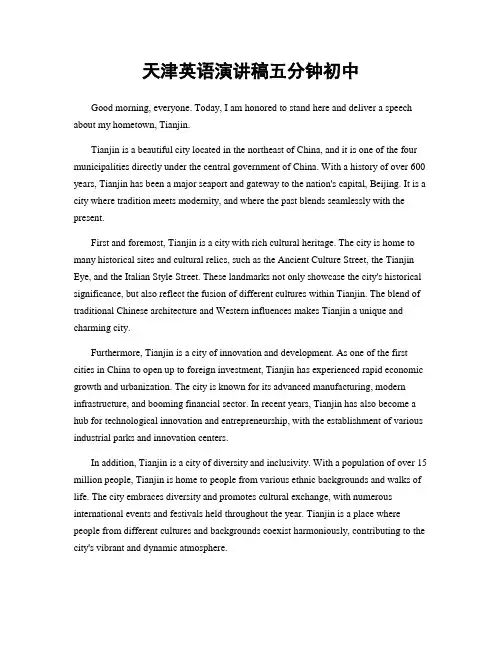
天津英语演讲稿五分钟初中Good morning, everyone. Today, I am honored to stand here and deliver a speech about my hometown, Tianjin.Tianjin is a beautiful city located in the northeast of China, and it is one of the four municipalities directly under the central government of China. With a history of over 600 years, Tianjin has been a major seaport and gateway to the nation's capital, Beijing. It is a city where tradition meets modernity, and where the past blends seamlessly with the present.First and foremost, Tianjin is a city with rich cultural heritage. The city is home to many historical sites and cultural relics, such as the Ancient Culture Street, the Tianjin Eye, and the Italian Style Street. These landmarks not only showcase the city's historical significance, but also reflect the fusion of different cultures within Tianjin. The blend of traditional Chinese architecture and Western influences makes Tianjin a unique and charming city.Furthermore, Tianjin is a city of innovation and development. As one of the first cities in China to open up to foreign investment, Tianjin has experienced rapid economic growth and urbanization. The city is known for its advanced manufacturing, modern infrastructure, and booming financial sector. In recent years, Tianjin has also become a hub for technological innovation and entrepreneurship, with the establishment of various industrial parks and innovation centers.In addition, Tianjin is a city of diversity and inclusivity. With a population of over 15 million people, Tianjin is home to people from various ethnic backgrounds and walks of life. The city embraces diversity and promotes cultural exchange, with numerous international events and festivals held throughout the year. Tianjin is a place where people from different cultures and backgrounds coexist harmoniously, contributing to the city's vibrant and dynamic atmosphere.Last but not least, Tianjin is a city of natural beauty. Situated along the coast of the Bohai Sea, Tianjin boasts stunning natural scenery, including the Haihe River, the Beidagang Wetland Park, and the Dagu Fort. The city's parks and green spaces provide a peaceful retreat from the bustling urban life, allowing residents and visitors to connect with nature and enjoy the serenity of the outdoors.In conclusion, Tianjin is a city that embodies the perfect blend of tradition and modernity, history and innovation, diversity and natural beauty. It is a city that holds a special place in my heart, and I am proud to call it my hometown. I hope that through my speech, you have gained a deeper understanding and appreciation for this extraordinary city. Thank you.。



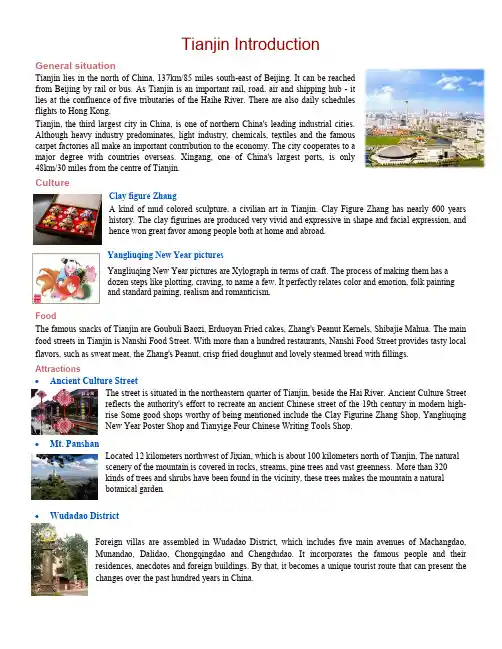
Tianjin IntroductionGeneral situationTianjin lies in the north of China, 137km/85 miles south-east of Beijing. It can be reachedfrom Beijing by rail or bus. As Tianjin is an important rail, road, air and shipping hub - itlies at the confluence of five tributaries of the Haihe River. There are also daily schedulesflights to Hong Kong.Tianjin, the third largest city in China, is one of northern China's leading industrial cities.Although heavy industry predominates, light industry, chemicals, textiles and the famouscarpet factories all make an important contribution to the economy. The city cooperates to amajor degree with countries overseas. Xingang, one of China's largest ports, is only48km/30 miles from the centre of Tianjin.CultureClay figure ZhangA kind of mud colored sculpture, a civilian art in Tianjin. Clay Figure Zhang has nearly 600 yearshistory. The clay figurines are produced very vivid and expressive in shape and facial expression, andhence won great favor among people both at home and abroad.Yangliuqing New Year picturesYangliuqing New Year pictures are Xylograph in terms of craft. The process of making them has adozen steps like plotting, craving, to name a few. It perfectly relates color and emotion, folk paintingand standard paining, realism and romanticism.FoodThe famous snacks of Tianjin are Goubuli Baozi, Erduoyan Fried cakes, Zhang's Peanut Kernels, Shibajie Mahua. The main food streets in Tianjin is Nanshi Food Street. With more than a hundred restaurants, Nanshi Food Street provides tasty local flavors, such as sweat meat, the Zhang's Peanut, crisp fried doughnut and lovely steamed bread with fillings.Attractions∙ Ancient Culture StreetThe street is situated in the northeastern quarter of Tianjin, beside the Hai River. Ancient Culture Streetreflects the authority's effort to recreate an ancient Chinese street of the 19th century in modern high-rise Some good shops worthy of being mentioned include the Clay Figurine Zhang Shop, YangliuqingNew Year Poster Shop and Tianyige Four Chinese Writing Tools Shop.∙ Mt. PanshanLocated 12 kilometers northwest of Jixian, which is about 100 kilometers north of Tianjin, The naturalscenery of the mountain is covered in rocks, streams, pine trees and vast greenness. More than 320kinds of trees and shrubs have been found in the vicinity, these trees makes the mountain a naturalbotanical garden.∙ Wudadao DistrictForeign villas are assembled in Wudadao District, which includes five main avenues of Machangdao,Munandao, Dalidao, Chongqingdao and Chengdudao. It incorporates the famous people and theirresidences, anecdotes and foreign buildings. By that, it becomes a unique tourist route that can present thechanges over the past hundred years in China.。
成长在天津英文演讲稿高中Growing up in Tianjin。
Growing up in Tianjin, I have experienced the unique blend of traditional culture and modern development that this city has to offer. From the bustling streets to the serene parks, Tianjin has shaped me into the person I am today.One of the most memorable aspects of growing up in Tianjin is the rich cultural heritage that is evident throughout the city. Whether it's the traditional architecture of the ancient temples or the vibrant celebrations of Chinese festivals, there is always a sense of history and tradition that permeates the air. As a young child, I was fascinated by the stories of the city's past and the customs that have been passed down through generations. This cultural richness has instilled in me a deep appreciation for the importance of preserving our heritage and traditions.In addition to its cultural significance, Tianjin has also been a city of growth and progress. The rapid development and modernization of the city have provided me with countless opportunities for learning and personal development. The world-class educational institutions and the diverse range of extracurricular activities have allowed me to explore my interests and develop new skills. The city's dynamic environment has taught me the value of adaptability and the importance of embracing change.Furthermore, growing up in Tianjin has exposed me to a melting pot of different cultures and perspectives. The city's diverse population has allowed me to interact with people from all walks of life, broadening my understanding of the world and fostering a sense of empathy and open-mindedness. I have learned to appreciate the beauty of diversity and the strength that comes from unity in the face of differences.As I continue to grow and mature, I carry with me the lessons and experiences that Tianjin has provided. The values of tradition, the spirit of progress, and the embrace of diversity have become an integral part of who I am. I am proud to have grown up in a city that has shaped me in such a profound way.In conclusion, growing up in Tianjin has been a truly enriching experience. The city's rich cultural heritage, its dynamic environment, and its diverse population have all played a significant role in shaping my identity. I am grateful for the opportunities and lessons that Tianjin has provided, and I look forward to carrying these with me as I continue to grow and thrive in the future. Thank you.。
成长在天津英文演讲稿Growing up in Tianjin。
Growing up in Tianjin, a bustling metropolis in northern China, has been a formative experience that has shaped me into the person I am today. From the rich history and culture to the rapid development and modernization, Tianjin has provided me with a unique perspective on life and a deep appreciation for my roots.One of the most striking aspects of Tianjin is its blend of traditional and modern elements. The city is home to ancient temples, historic architecture, and traditional tea houses, which stand in stark contrast to the sleek skyscrapers, high-speed trains, and bustling shopping malls. This juxtaposition of old and new has taught me to embrace change while also cherishing the past, and has instilled in me a sense of adaptability and resilience.Moreover, Tianjin's diverse population has exposed me to different languages, customs, and traditions, fostering a spirit of openness and inclusivity within me. I have had the opportunity to interact with people from various backgrounds, learning from their experiences and broadening my understanding of the world. This multicultural environment has equipped me with the ability to communicate effectively with individuals from all walks of life, and has instilled in me a deep respect for diversity.Additionally, Tianjin's emphasis on education and innovation has played a significant role in shaping my mindset. The city is home to prestigious universities, research institutions, and high-tech industries, which have inspired me to pursue knowledge and strive for excellence. The spirit of innovation and entrepreneurship that permeates the city has fueled my own ambitions and encouraged me to think outside the box, constantly seeking new solutions to challenges.Furthermore, the strong sense of community in Tianjin has taught me the value of unity and cooperation. Whether it is coming together to celebrate traditional festivals, support each other in times of need, or work towards common goals, the people ofTianjin have shown me the power of solidarity and mutual support. This spirit of togetherness has instilled in me a deep sense of belonging and has shaped my understanding of the importance of building strong, supportive relationships.In conclusion, growing up in Tianjin has been a transformative experience that has shaped my values, beliefs, and aspirations. The city's unique blend of tradition and modernity, its multicultural environment, emphasis on education and innovation, and strong sense of community have all contributed to my personal and professional growth. I am proud to call Tianjin my home, and I carry the lessons and experiences from my upbringing with me as I continue to navigate life's journey. Thank you.。
天津的英语介绍
Tianjin is a famous city in china, standing by BoHai sea, I was born in here。
And Tianjin is the economy center of north china. It has long history and rich culture.
In the city, there is a large river calls“haihe”, people visit the Haihe river everyday, it is very beautiful whenever day and night, we all like it.
As we all know, Tianjin has a lot of good delicious food, such as “goubuli” and “mahua”.
This is my hometown, I am proud of it, welcome to Tianjin.
天津是一个著名的城市在中国,位于渤海之滨,我就出生在这里。
同
时天津也是北方的经济中心,它有着悠久的历史和丰富的文化。
在城市之中,有一条很大的河叫海河,人们每天都会在海河游玩。
它非常漂亮无论在白天还是夜晚,我们都很喜欢它。
众所周知,天津有很多美味可口的食物,比如“狗不理”和“麻花”。
这就是我的家乡,我以它为荣,欢迎大家来天津!。